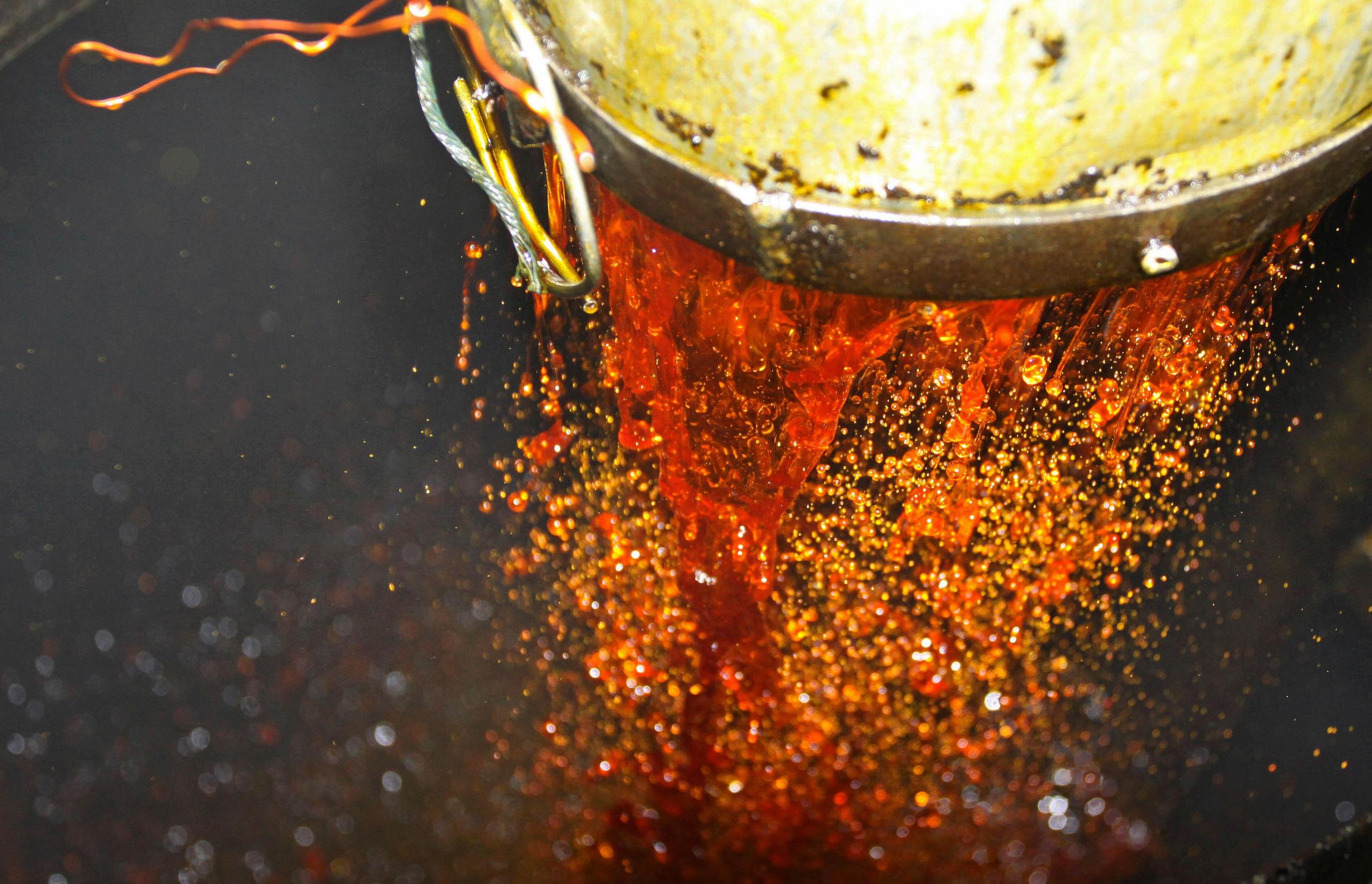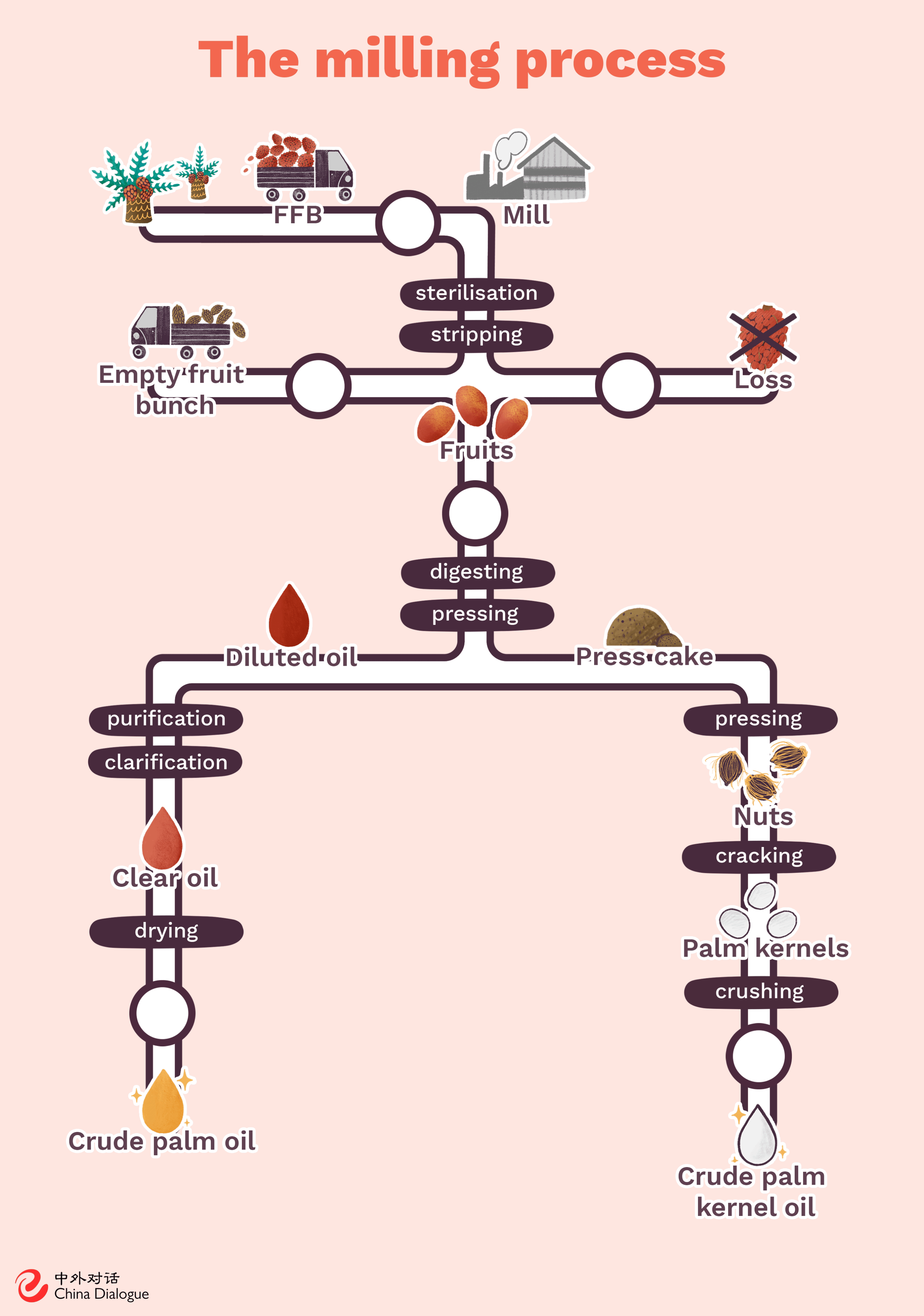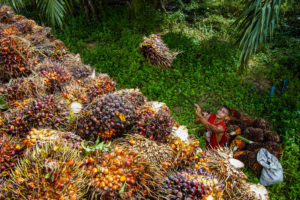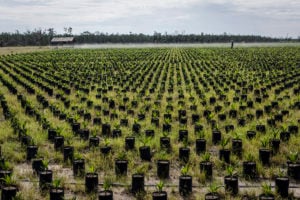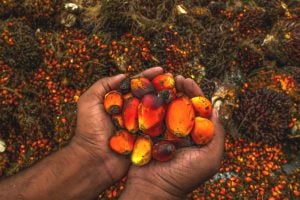The media often highlights the prevalence of palm oil in food and household products, as well as the deforestation linked to it. But there is a general lack of awareness of the existence of the commodity in its other forms, such as fatty acids, fatty alcohols and glycerol. It is little understood just how widely and increasingly these forms are used in chemical and industrial manufacturing sectors such as pharmaceuticals, paint and plastics.
Such sectors have complex supply chains with very little transparency, which has perhaps helped them fly under the radar of campaign groups. But with the climate and biodiversity crises intensifying, it’s never been more important to explore the ties between palm oil and these lesser-known industries.
Production of the world’s most popular vegetable oil has increased five-fold in the past three decades, to nearly 77 million tonnes in 2021. The rapid expansion of oil palm plantations across the tropics has contributed to land degradation and greenhouse gas emissions, driving NGOs to campaign for sustainability and accountability.
Proponents draw attention to palm’s high yield and low production costs compared with other vegetable oils, though this may mask some of its social and environmental impact.
Like most oils, it is a mixture of compounds that can be broken down into hundreds of derivatives. These are useful in myriad products, from chocolate and pizza, to toothpaste and shampoo, and even paper and fire retardant.
Palm oil processing is a highly adaptable process: many different pathways can be followed. Because the oil is stable at high temperatures, blends well with other ingredients and has a natural preservative effect, it and its derivatives have become sought-after workhorse ingredients in countless edible and non-edible products.
Like most oils, palm oil is seldom used in its crude form. The pungent, reddish-orange oil is first refined and physically separated into different components known as fractions. Using chemical reactions, it may then be broken down further to produce compounds called oleochemicals.
Any material that is palm-based can be considered a palm oil derivative, and as we will see, it is no easy feat to examine the true extent to which palm-based derivatives are embedded in our lives.
What are palm oil derivatives?
Fractions and other derivatives of crude palm oil account for about 60% of global palm oil consumption. But the complexity of their supply chains makes it far more difficult to trace and assess whether they have been produced sustainably. In some cases, derivatives may go through double-digit transformations before reaching a final product.
Whatever chemical pathway palm oil follows, it all begins with the supply of fresh fruit bunches from an oil palm plantation to a mill. Once there, the bunches are stripped and processed into crude palm oil and crude palm kernel oil. While the crude oil is extracted by pressing the flesh of the fruit, the kernel oil comes from crushing the fruit seeds. The average extraction rate from fresh fruit is around 20% for palm oil and 2–5% for palm kernel oil – so for every 1,000 kg (1 tonne) of fresh fruit bunches, 200 kg of crude palm oil and 20–50 kg of crude kernel oil can be drawn out.
From the mill, the crude palm oil and kernel oil are transported to refineries where they are refined, bleached and deodorised. The physical refining process removes any unwanted substances such as free fatty acids, phosphatides and metallic compounds. Physical refining is usually preferred to chemical refining because it requires less chemicals, produces less liquid waste and has a higher overall yield.
A by-product of the refining process is palm fatty acid distillate. This light brown, semi-solid, non-edible residue is becoming increasingly popular as a feedstock in biodiesel production, as well as to produce candles, soaps, animal feed and certain chemical products. Around 3 million tonnes of fatty acid distillate are produced globally every year through palm oil refining. There is some debate over whether it should be considered a “processing residue” at all, due to its market value and many uses.
Rising demand for palm oil in the manufacture of food and chemical products has underpinned huge technological advancement in its physical and chemical processing since the 1980s. Fractionation is the most common method of extracting useful products from refined palm oil and kernel oil. It entails physically separating the oil into liquid and solid fractions using crystallisation.
The liquid fat fractions or “oleins” contain unsaturated molecules making them perfect for products that melt at a medium heat, such as cooking oils. While the solid fat fractions or “stearins” contain more saturated molecules and are used in things like margarine and vegetable ghee that melt at a high heat.
Oleins and stearins can then be fractionated further to create super oleins, super stearins and harder palm mid-fractions. These multiple-step fractionation processes yield higher added-value products.
What about oleochemicals?
At its simplest an oleochemical is a compound chemically derived from animal or vegetable oils or fats.
All oils and fats consist of triglycerides – long carbon chains linked together with a glycerol backbone. The type and length of the chain determines its viscosity (thickness) and resistance to high temperature. Oleochemicals are produced through chemical reactions which alter the triglyceride chain structure to unlock further potential uses and applications, such as in adhesives and cleaning products. They may come from a mixture of coconut, soya and other vegetable oils – many of which are now facing questions over their sustainability, but since palm oil is the cheapest and highest yielding, it’s often the main raw material.
The major feedstocks for palm-based oleochemical production are refined oil and refined kernel oil, stearin and fatty acid distillate. There may be many transformations before the desired end product is reached.
According to Efeca, only 8% of the world’s palm oil and 70% of its palm kernel oil went into oleochemical production in 2016. But the market for oleochemicals is certainly growing, with chemical companies such as Cargill and DuPont increasingly touting bio-based feedstocks as a lower-emission alternative to fossil fuel-derived products.
The main process for deriving oleochemicals is hydrolysis (also known as splitting). This sees the large triglyceride molecules broken down into mixed length fatty acids using high pressure steam. Other reactions which alter the chemical structure and physical characteristics of the molecules include “transesterification”. This involves reacting fatty acids with alcohol to produce fatty acid methyl esters, which as we will see are used to produce detergents and biodiesel.
The complex nature and many transformations of these palm-based oleochemicals make it very difficult for downstream users to trace production back to source, and make sure of sustainability. To tackle issues around transparency, leading industry standard the Roundtable on Sustainable Palm Oil (RSPO) introduced rules for oleochemicals and derivatives back in 2013. These rules closed a gap between the business practices of downstream users of oleochemicals, and the RSPO’s Supply Chain Certification Standard – which audits facilities handling certified oil palm products along the supply chain. They define fatty acids (FACs), fatty alcohols (FOHs), fatty acid methyl esters (FAMEs) and glycerol as the four primary oleochemicals. Products that come from further chemical conversions of these are classed as secondary oleoderivatives.
Why does it matter?
For years, environmental groups have targeted large users of palm oil with campaigns to raise awareness of the environmental and social impacts of its production. Their targets are usually large multinational corporations that use oil palm products in the manufacturing of fast-moving consumer goods – companies like Unilever, Nestlé and PepsiCo. These campaigns have gone a long way to raise consumer awareness of the prevalence of palm oil in many edible and non-edible goods, and to encourage brands to make decisions over whether to go “palm-oil free” or source sustainably produced palm oil.
In line with consumer demand for sustainable produce, palm oil producers and users have been taking steps to improve the transparency and traceability of their palm oil sourcing. But for manufacturing processes and product materials that continue to fly under the radar, there is little opportunity to leverage for change and little impetus for users to step up action for sustainability. Within these industrial and chemical manufacturing sectors, palm oil is being increasingly touted as a green and renewable feedstock. But with such murky supply chains and little assurance that palm oil has been produced free of deforestation and exploitation, work is needed to understand how viable it is as an alternative to petrochemical processes. By fostering a deeper understanding and awareness of these processes, we may yet unlock new pathways for sustainable palm oil.
This is Part One of a two-part series looking at palm oil derivatives in industrial and chemical manufacturing processes. Part Two will take a deeper dive into these industries and the wider context of palm oil’s prevalence.
This article is part of our ongoing series on palm oil. Explore the series to date here.
